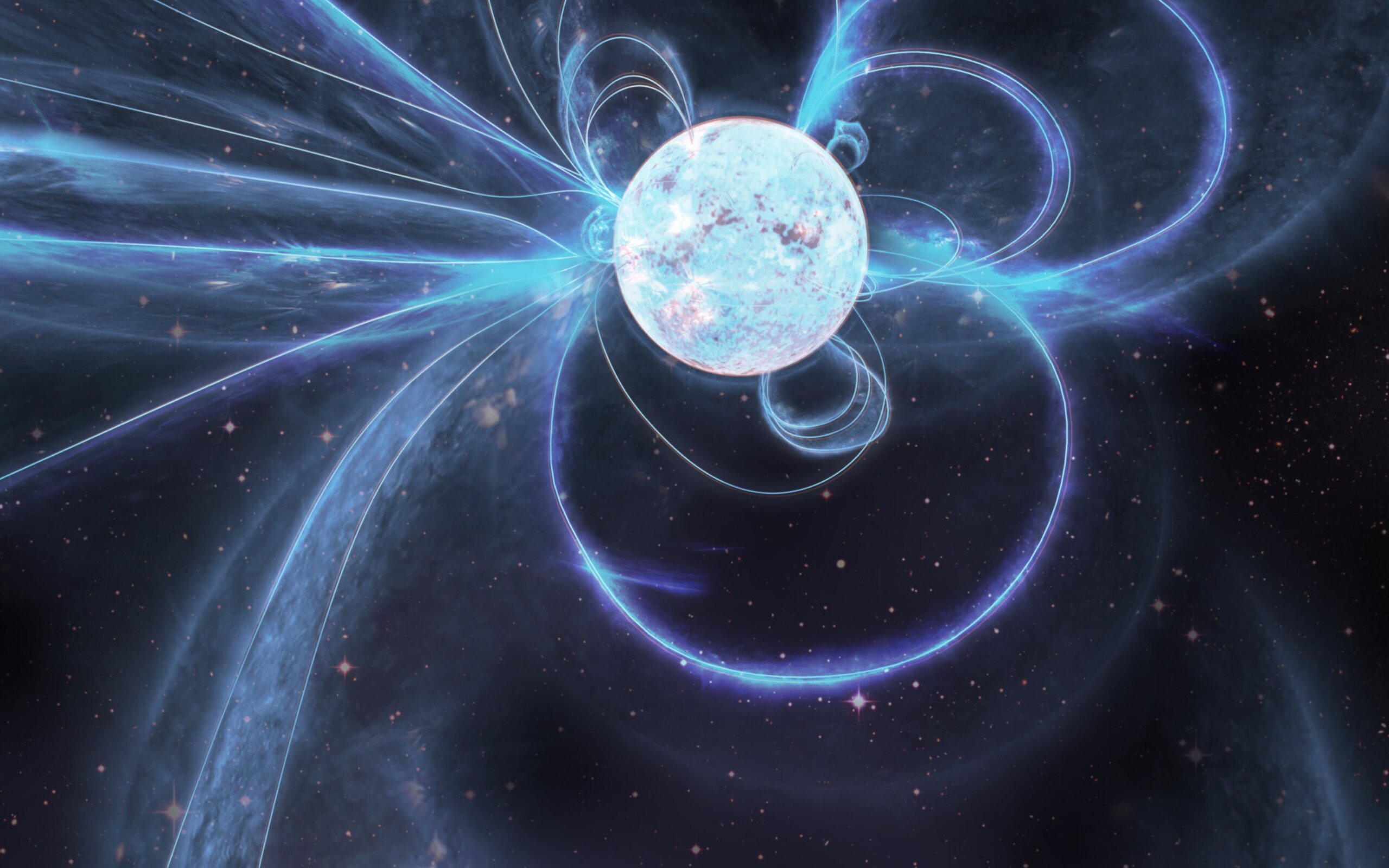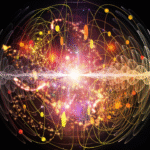When most stars die, the story ends in silence. Their flames go out, their light fades, and all that’s left is a dense heart — a neutron star or a black hole. But somewhere between those two fates might exist something far stranger: a quark star — an object so dense that even the laws of physics feel the pressure.
What Is a Quark Star?
A quark star is a hypothetical type of star that forms when a dying massive star collapses beyond the neutron star stage but stops short of becoming a black hole. Inside, matter is crushed so tightly that quarks — the fundamental building blocks of protons and neutrons — break free, forming an exotic soup called quark matter.
Think of it as the next level of stellar density — where the universe stops playing by the usual rules.
Imagine taking the entire Mount Everest and crushing it into the size of a sugar cube. Now imagine going further — squeezing it until the very particles that make up atoms start falling apart. That’s what nature might do when it creates a quark star.
To understand how that’s even possible, let’s travel inward — deep into the layers of matter itself.
At the surface of everything we touch are atoms, the basic units of matter. Inside each atom is a nucleus made of protons and neutrons. Zoom in even closer, and you’ll find that protons and neutrons themselves are built from quarks — tiny, fundamental particles bound tightly together by the strongest force in the universe, the strong nuclear force.
Normally, these quarks never escape. They’re like prisoners chained together — no matter how much energy you throw at them, they stay locked inside protons and neutrons. But there’s one environment where even the strongest prison walls can break: the heart of a dying giant star.
From Stars to Quark Stars: How They Form
Every star’s life ends when it runs out of fuel. Massive stars, those several times larger than our Sun, explode in a supernova, leaving behind an incredibly dense core.
If that core isn’t massive enough to become a black hole, it stabilizes as a neutron star, made mostly of tightly packed neutrons. But if the collapse continues — if gravity squeezes the neutrons even further — their structure shatters. The neutrons themselves break down into their internal components: quarks.
When that happens, the result is a quark star, made almost entirely of free quarks instead of atomic nuclei.
Imagine crushing Earth into the size of a marble, then pressing even harder until the marble becomes a tiny droplet of quark matter — that’s roughly what happens inside a quark star.
If the collapsing core is small enough, the particles get squished into neutrons, and it stabilizes as a neutron star — a city-sized sphere of matter so dense that a teaspoon of it would weigh a billion tons. That’s already hard to imagine. But gravity doesn’t always stop there.
This is what we call a quark star — an object made not of atoms or even neutrons, but of the raw ingredients of reality itself.
What Makes Quark Stars Different from Neutron Stars
A neutron star is already an extreme object: just a few kilometers across but heavier than our Sun. A quark star is smaller and denser than a neutron star, but not as dense as a black hole. It sits right at the edge, balanced between existence and collapse.
Inside a neutron star, matter is compressed into neutrons. Inside a quark star, those neutrons dissolve, freeing their quarks into a dense, fluid-like state. This “quark soup” could contain not only up and down quarks (which make up normal matter) but also strange quarks, forming what physicists call strange matter.
In this extreme state, protons and neutrons no longer exist as individual particles. Everything melts together into a super-dense quark soup, glowing faintly with leftover heat and energy.
If you could somehow stand near one (which, of course, you couldn’t — you’d be torn apart instantly), it might appear like a faint, ghostly ember — incredibly small, incredibly hot, and impossibly dense.
How Dense Is a Quark Star?
To imagine the density, take a grain of sand and pack into it the mass of an entire mountain. The quarks inside this star are squeezed so tightly that they move freely in a fluid-like state, a bit like how air molecules move in a room — except the “room” is only a few kilometers wide, and the “air” weighs more than our Sun.
A single teaspoon of quark star material would weigh billions of tons — more than all the cars and mountains on Earth combined.
At such density, light itself struggles to escape. These stars may appear faint or invisible, glowing only in X-rays or gamma rays detectable by specialized telescopes.
Now here’s where it gets even more fascinating. Scientists have proposed that strange matter might be more stable than ordinary matter. In theory, if a piece of it ever touched regular atoms, it could turn them into strange matter too — like a chain reaction. A “strangelet,” as it’s sometimes called, could spread and convert everything it touches.
That sounds like something from science fiction, but don’t worry — there’s no evidence this actually happens. It’s more of a thought experiment that shows how deeply we still don’t understand matter under extreme conditions.
What Keeps a Quark Star from Becoming a Black Hole?
What keeps a quark star from collapsing into a black hole? The answer lies in a strange quantum rule known as degeneracy pressure — a kind of resistance that arises because no two identical particles can occupy the same state at the same time.
This principle keeps white dwarfs stable (thanks to electrons) and neutron stars stable (thanks to neutrons). In quark stars, it’s the quarks themselves creating that pressure. It’s like a cosmic version of everyone trying to squeeze into a bus — the tighter it gets, the more they resist. That resistance is what prevents the star from collapsing completely, unless gravity becomes too strong.
If gravity does win, the quark star’s story ends in the ultimate collapse — it becomes a black hole, vanishing behind its own event horizon.
Could Quark Stars Really Exist?
Scientists haven’t confirmed any quark stars yet, but they’ve found mysterious objects that don’t quite fit the rules for neutron stars. Some are too small, too cold, or too light to be explained by current models. These could be quark stars hiding in plain sight — cosmic riddles waiting for better telescopes to solve.
One possible candidate, RX J1856.5−3754, glows dimly in X-rays, cooler than a typical neutron star. Another, 3C 58, seems to cool down faster than it should — a clue that quark matter might be inside, carrying heat away more efficiently.
Each of these clues pushes astronomers to wonder if we’ve already seen quark stars — we just didn’t know it.
Why Quark Stars Matter
Why should we care about these strange, invisible stars? Because they may hold the key to understanding how matter behaves at its most extreme. Quark stars are natural laboratories for the strongest force in the universe — the strong nuclear force — and they test the boundaries of quantum chromodynamics, the theory describing how quarks interact.
Studying them could answer questions about how the early universe behaved, just moments after the Big Bang, when everything was a hot soup of free quarks and gluons. In a way, looking for quark stars is like peering back in time — to when the universe itself was in its rawest, purest state.
Key Facts Recap
- Type: Hypothetical ultra-dense star
- Core composition: Free quarks (up, down, and possibly strange quarks)
- Density: Greater than neutron stars, less than black holes
- Formation: Collapse of a massive star beyond the neutron stage
- Size: Typically 10–12 km wide, with mass up to 2 solar masses
- Energy emission: X-rays, gamma rays
- Status: Unconfirmed but strongly theorized
In Simple Terms…
If normal stars are campfires and neutron stars are diamond-dense embers, quark stars are the ashes of the universe — the final, glowing reminder that matter can always go deeper.
They’re what happens when the universe asks, “What if I break matter down to its very soul?
Quark stars remind us that nature doesn’t stop at what we can easily see or explain. Matter can still surprise us, breaking its own rules under the crushing hand of gravity. Somewhere in the vast dark between galaxies, there might be tiny stars — no larger than a city — made of the most fundamental stuff in existence, shining faintly as the universe’s deepest experiment.
They are not just stars. They are what happens when the universe asks, “How far can I go before even matter itself gives in?”


